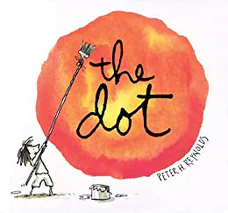The Dot
Written and illustrated by Peter H. Reynolds
32 pages
•
Published 2003 (Candlewick Press)

Recommended Age Range: Preschool through 2nd grade.
Publisher's Summary:
Art class is over, but Vashti is sitting glued to her chair in front of a blank piece of paper. The words of her teacher are a gentle invitation to express herself. But Vashti can’t draw — she’s no artist. To prove her point, Vashti jabs at a blank sheet of paper to make an unremarkable and angry mark. “There!” she says. That one little dot marks the beginning of Vashti’s journey of surprise and self-discovery.

Dr. Annie's Takeaways
Recommended for: This is a lovely read for a child who is reluctant to try something if they think they’re not good at it or won’t be good at it. It shows how just getting started can be the beginning of a new passion and a sense of accomplishment. It also suggests that being “good” at something is often a limited construct and that there are many ways to define success.
Would a child like it? Definitely. This book is really popular and has inspired many a child to make their mark.
Evidence-Based Practices:
Cognitive Restructuring
Tone: Joyful, inspiring
Story Quality: This story, written almost 20 years ago, has grown into a cultural institution with its own day of celebration, International Dot Day
. It’s a simple story that shows how starting somewhere small can lead to big things. It’s also a powerful story about how impactful it is for a child to be taken seriously by someone they admire. One of the great teachers of children’s literature is featured in this book. The story begins in art class where Vashti thinks she “can’t draw.” When her teacher tells her to “just make a mark and see where it takes you,” she angrily stabs the paper with her pen to make the titular dot. Her teacher asks her to sign her work, and when she arrives at school the next day, her teacher has framed and hung up her dot. This reinforcement inspires her to start drawing and painting all kinds of dots–big ones, small ones, colorful ones. Her teacher features her dots at an art show, and a little boy expresses his admiration of her artwork. “I can’t draw,” he says. She encourages him to draw a line on a page and once he’s done, she encourages him to sign it, just as her teacher had encouraged her. So sweet.
Illustrations: Fun, scribbly line drawings in black ink with watercolor accents in emotionally evocative colors.
Representation: Vashti is a girl with light colored skin and straight black hair. Her art teacher is a Black woman. Vashti helps a little boy to realize his artistic potential. He has brown skin and brown, curly hair.
Psychological Practices: The message of this story is that a child doesn’t have to be “good” at something in a traditional way in order to get started, and they don’t have to be perfect in order for someone to appreciate their work. It is also an excellent reminder to adults about the power of their attention and praise to motivate and encourage a child.
Concerns: None
